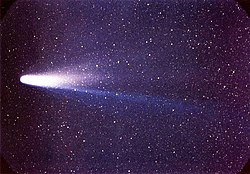Komet Halley
 |
|
Panamu
| |
|---|---|
| Ditamuan dek | prehistoric (observation); Edmond Halley |
| Jangka wakatu 2449400.5 (17 February 1994) |
|
| Aphelion | 35.1 AU (9 December 2023)[2] |
| Perihelion | 0.586 AU last perihelion: 9 February 1986 next perihelion: 28 July 2061[2] |
| Sumbu semi-mayor | 17.8 AU |
| Eksentrisitas | 0.967 |
| Periode orbit | 75.3 a[1] |
| Inklinasi | 162.3° |
Karakteristik fisik
| |
| Dimensi | 15×8 km,[3] 11 km (rato-rato)[1] |
| Masso | 2.2×1014 kg[4] |
| Masso jenis rato-rato |
0.6[5] (estimates range from 0.2 to 1.5 gr/cm3[6]) |
| Kacapatan palapehan | ~7.305 km/detik |
| Hari sideris | 2.2 d (52.8 h) (?)[7] |
| Albedo | 0.04[8] |
| Magnitudo | 28.2 (in 2003)[9] |
Komet Halley (pron.: /ˈhæli/ or /ˈheɪli/; rasmi ditandoi 1P/Halley)[1] marupoan benda langik nan tanamo sabagai salah satu komet maso pendek, dan benda ko buliah dilihek jo mato dari Bumi satiok 75 atau 76 taun.[1][10] Komet Halley adolah satu-satunyo Komet maso pendek nan sabana jaleh diliek jo mato kapalo dari bumi, penampakan ko mungkin dapek dilieek dek manusia duo kali sa umua hiduiknyo.[11] mungkin penampakannyo nan labiah spektakuler muncul satu kali dalam ribuan taun.
Rujukan
suntiang- ↑ a b c d e "JPL Small-Body Database Browser: 1P/Halley". Jet Propulsion Laboratory. 11 January 1994 last obs. Diakses tanggal 13 October 2008.
- ↑ a b Donald K. Yeomans. "Horizon Online Ephemeris System". California Institute of Technology, Jet Propulsion Laboratory. Diakses tanggal 8 September 2006.
- ↑ "What Have We Learned About Halley's Comet?". Astronomical Society of the Pacific (No. 6 — Fall 1986). 1986. Diakses tanggal 16 December 2008.
- ↑ G. Cevolani, G. Bortolotti and A. Hajduk (1987). "Halley, comet's mass loss and age". Il Nuovo Cimento C. Italian Physical Society. 10 (5): 587–591. Bibcode:1987NCimC..10..587C. doi:10.1007/BF02507255.[pranala nonaktif permanen]
- ↑ R. Z. Sagdeev, P. E. Elyasberg, V. I. Moroz. (1988). "Is the nucleus of Comet Halley a low density body?". Nature. 331 (6153): 240–242. Bibcode:1988Natur.331..240S. doi:10.1038/331240a0.
- ↑ S. J. Peale (1989). "On the density of Halley's comet". Icarus. 82 (1): 36–49. Bibcode:1989Icar...82...36P. doi:10.1016/0019-1035(89)90021-3.
densities obtained by this procedure are in reasonable agreement with intuitive expectations of densities near 1 g/cm3, the uncertainties in several parameters and assumptions expand the error bars so far as to make the constraints on the density uniformative ... suggestion that cometary nuclei tend to by very fluffy, ... should not yet be adopted as a paradigm of cometary physics.
- ↑ S. J. Peale, J. J. Lissauer (1989). "Rotation of Halley's Comet". Icarus. 79 (2): 396–430. Bibcode:1989Icar...79..396P. doi:10.1016/0019-1035(89)90085-7.
- ↑ R. R. Britt (29 November 2001). "Comet Borrelly Puzzle: Darkest Object in the Solar System". Space.com. Diarsipkan dari versi asli tanggal 30 November 2001. Diakses tanggal 16 December 2008.
- ↑ "New Image of Comet Halley in the Cold". European Southern Observatory. 1 September 2003. Diarsipkan dari versi asli tanggal 27 August 2009. Diakses tanggal 22 February 2009.
- ↑ G. W. Kronk. "1P/Halley". cometography.com. Diakses tanggal 13 October 2008.
- ↑ M. Delehanty. "Comets, awesome celestial objects". AstronomyToday. Diarsipkan dari versi asli tanggal 21 October 2019. Diakses tanggal 15 March 2007.